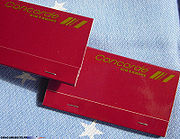
Matchbook
Encyclopedia
.jpg)

Paperboard
Paperboard is a thick paper based material. While there is no rigid differentiation between paper and paperboard, paperboard is generally thicker than paper. According to ISO standards, paperboard is a paper with a basis weight above 224 g/m2, but there are exceptions. Paperboard can be single...
folder (matchcover) enclosing a quantity of match
Match
A match is a tool for starting a fire under controlled conditions. A typical modern match is made of a small wooden stick or stiff paper. One end is coated with a material that can be ignited by frictional heat generated by striking the match against a suitable surface...
es and having a coarse striking surface on the exterior. The folder is opened to access the matches, which are attached in a comb-like arrangement and must be torn away before use in contrast to a matchbox where the matches are loosely packed in the interior tray.
The exterior of the matchcover is usually imprinted with a producer's logo, often with artistic decorations, or serves as an advertising/promotional media for the undertaking it is sold or handed off in. The ease of making matchcovers of different shapes also made them quite a popular cheap promotional item or anniversary souvenir.
Manufacturing of matchbooks peaked during the 1940s and 50s, then steadily declined because of the availability of disposable lighter
Lighter
A lighter is a portable device used to generate a flame. It consists of a metal or plastic container filled with a flammable fluid or pressurized liquid gas, a means of ignition, and some provision for extinguishing the flame.- History :...
s and various anti-smoking health campaigns. Recently, matchbooks have begun to regain some of their popularity as a "retro" advertising item, particularly in high-end restaurants.
Although paper matches were patented in the 1880s, an early paper match "folder" was patented in September 1892 by Philadelphia patent attorney American
United States
The United States of America is a federal constitutional republic comprising fifty states and a federal district...
Joshua Pusey
Joshua Pusey
Joshua Pusey , was an American inventor and an attorney.In 1827, an English pharmacist named John Walker produced his "sulphuretted peroxide strikables," gigantic, yard-long sticks that can be considered the real precursor of today’s match. Small phosphorus matches were first marketed in Germany...
, however the matchbook as we know it was patented a few weeks later by Charles Bowman of Lebanon, PA. Pusey challenged Bowman's patent, but Bowman's patent was upheld. Pusey sold his patent to the Diamond Match Trust in 1896 and then served as the company's patent attorney. Bowman's company, the American Safety Head Match Company of Lebanon, PA did not last long, and Diamond Match Co. adapted his design into their product, becoming the first mass-producer of paper matchbooks.
Collecting of matchboxes, matchbooks, match labels and other match-related items is called phillumeny.
Matchcover
A "matchcover", or "matchbook cover", is a thin cardboard covering that folds over matchMatch
A match is a tool for starting a fire under controlled conditions. A typical modern match is made of a small wooden stick or stiff paper. One end is coated with a material that can be ignited by frictional heat generated by striking the match against a suitable surface...
sticks in a "book" or "pack" of matches. Covers have been used as a form of advertising
Advertising
Advertising is a form of communication used to persuade an audience to take some action with respect to products, ideas, or services. Most commonly, the desired result is to drive consumer behavior with respect to a commercial offering, although political and ideological advertising is also common...
since 1894, two years after they were patented, and since then, have attracted people who enjoy the hobby of collecting
Collecting
The hobby of collecting includes seeking, locating, acquiring, organizing, cataloging, displaying, storing, and maintaining whatever items are of interest to the individual collector. Some collectors are generalists, accumulating merchandise, or stamps from all countries of the world...
.
Collectors are known as phillumenists, or "lovers of light", and include people who have a shoe box or fish bowl filled with packs from local stores and restaurants, to serious collectors with covers organized in hundreds of different topics. In 2005, there were over 1800 active collectors in The Rathkamp Matchcover Society (The Voice of the Hobby Since 1941), spread over 20 countries worldwide.
Patents
US patent 483,166 Flexible Match patent, 27 September 1892 - set of 2 match combs shown enclosed folding paper match cover.See also
- Phillumeny - The hobby of collecting matchbooks, matchboxes, and other match related items.
- MatchboxMatchboxA matchbox is a box made of cardboard or thin wood designed to hold matches. It usually has a coarse striking surface on one edge for lighting the matches contained inside....
- another method of delivering matches (and advertising).

